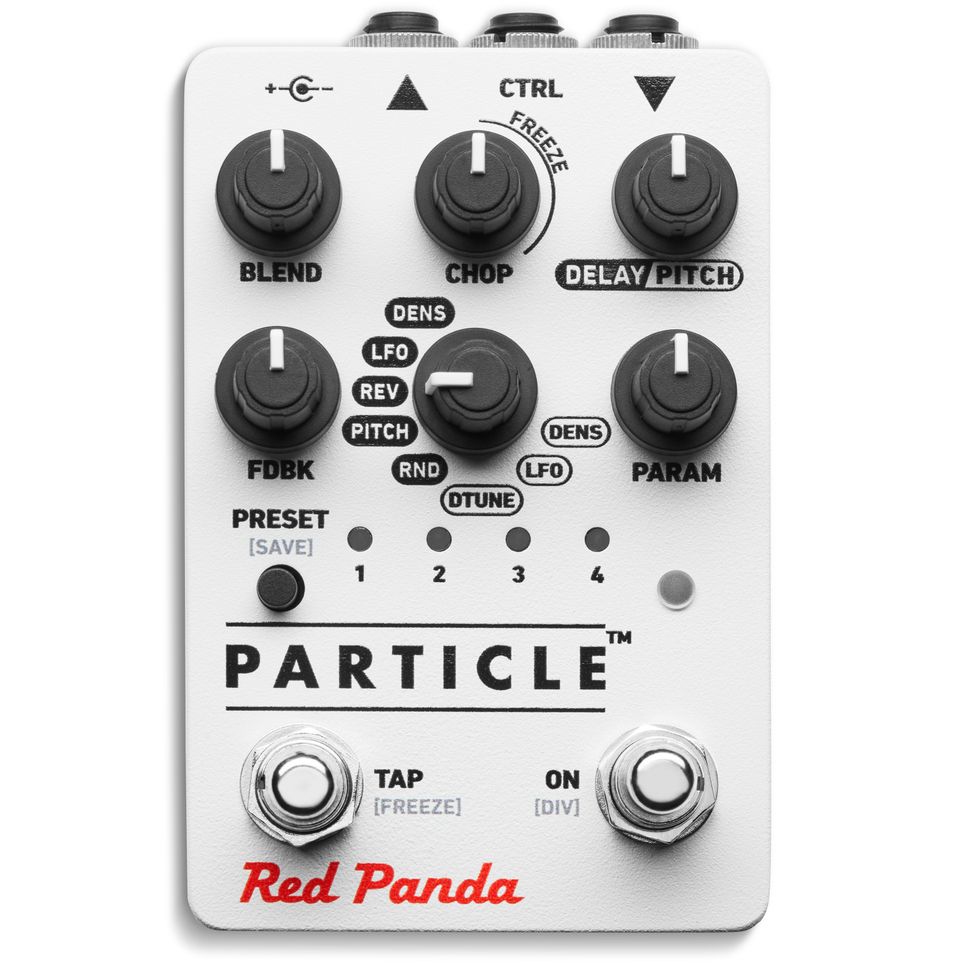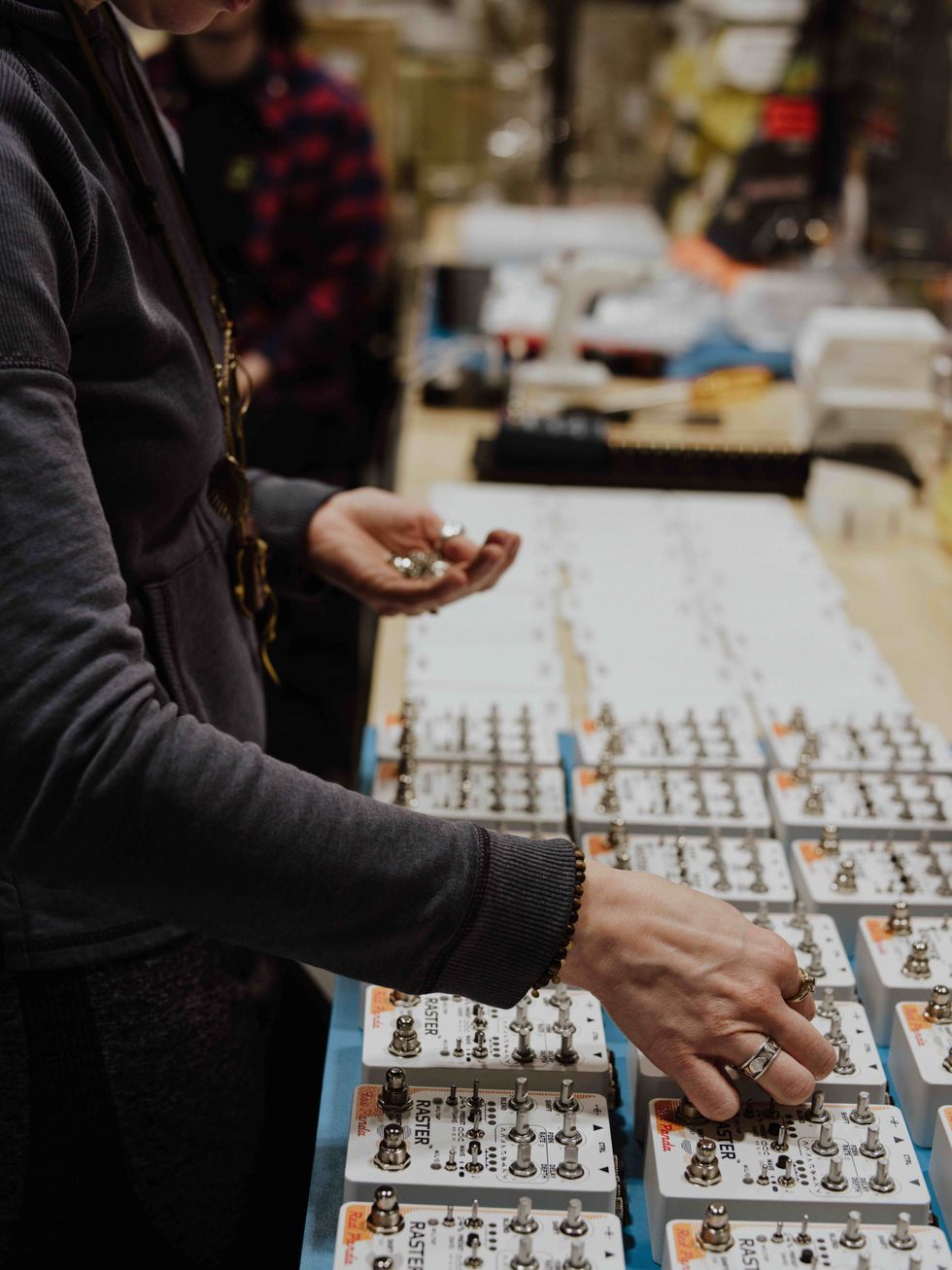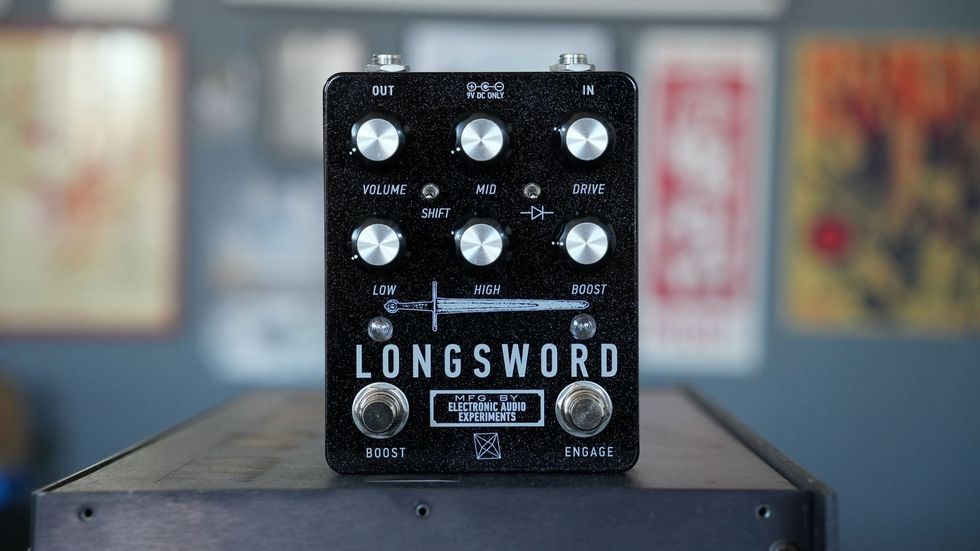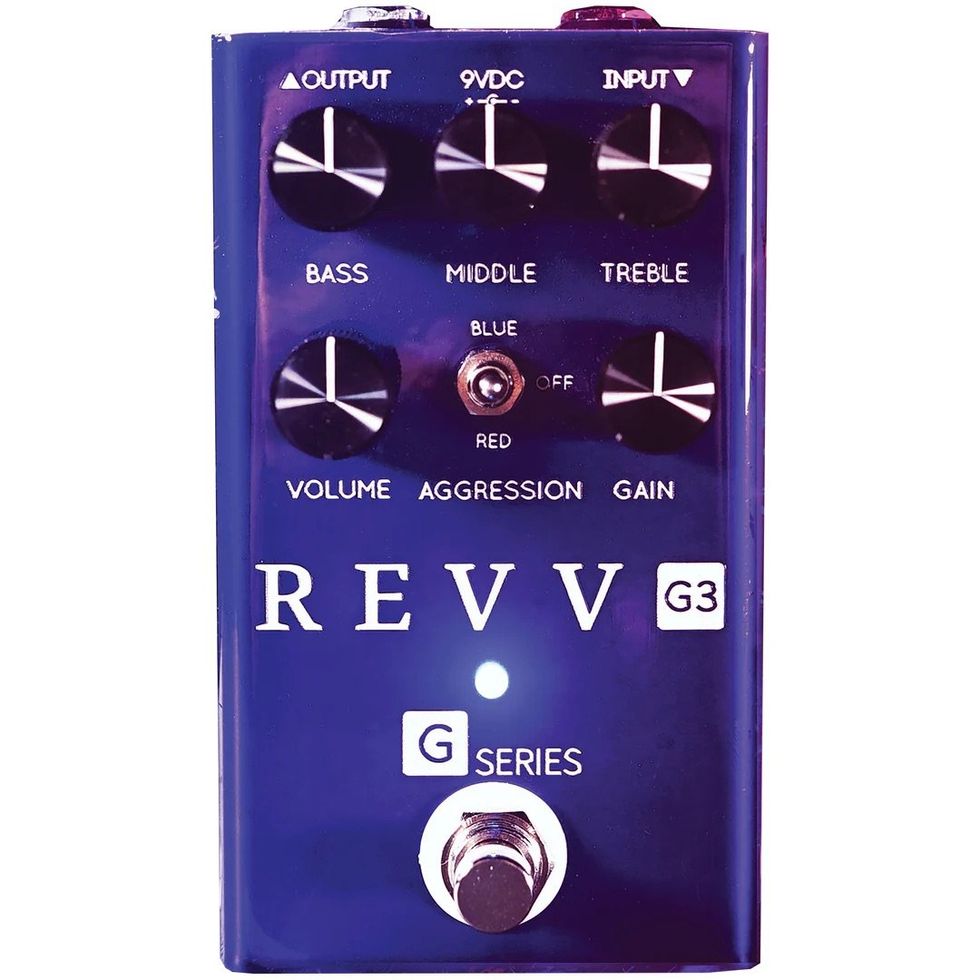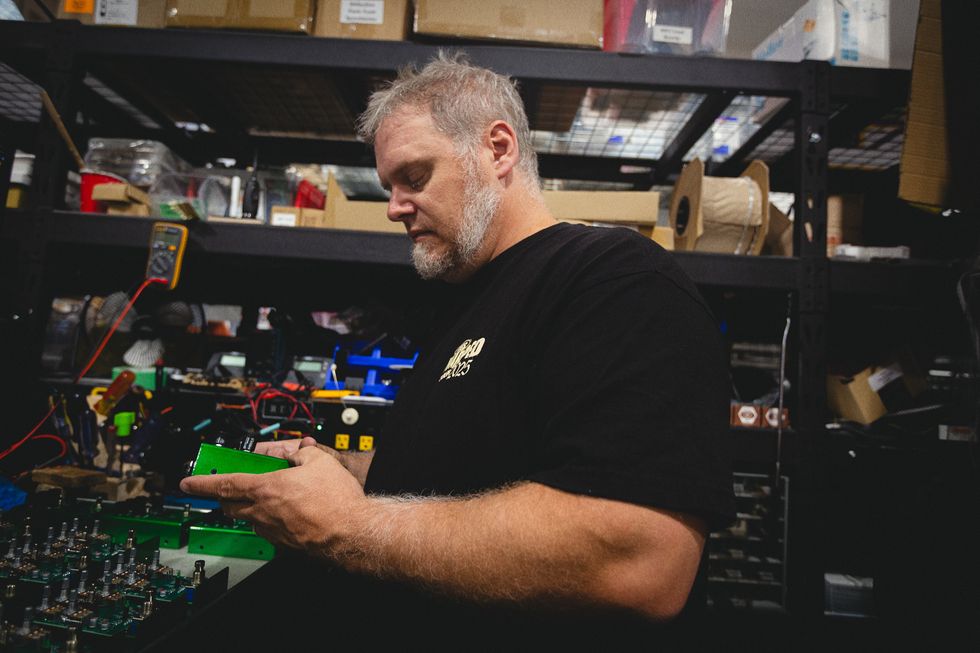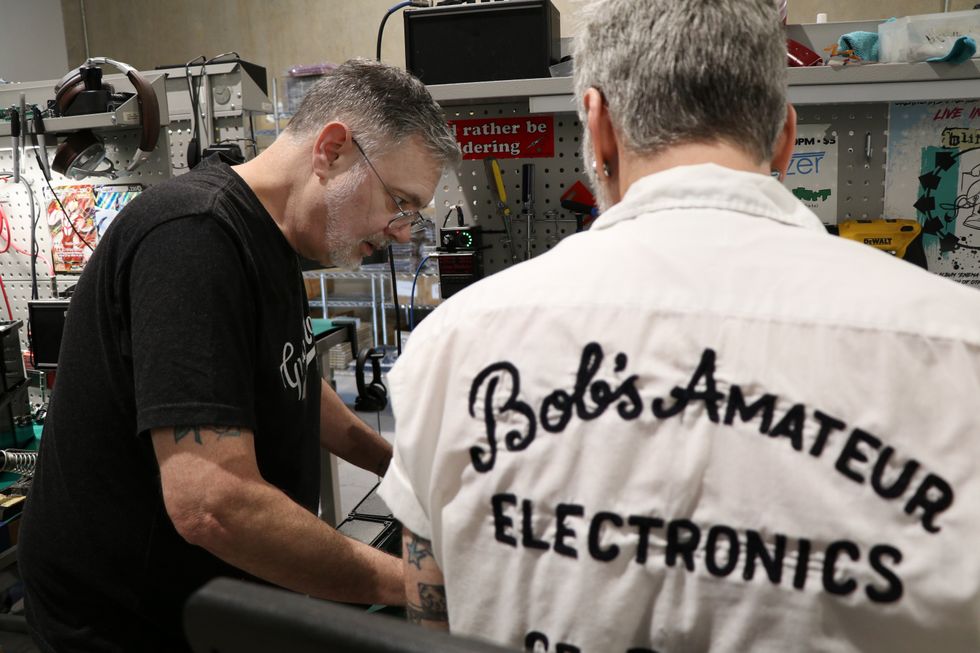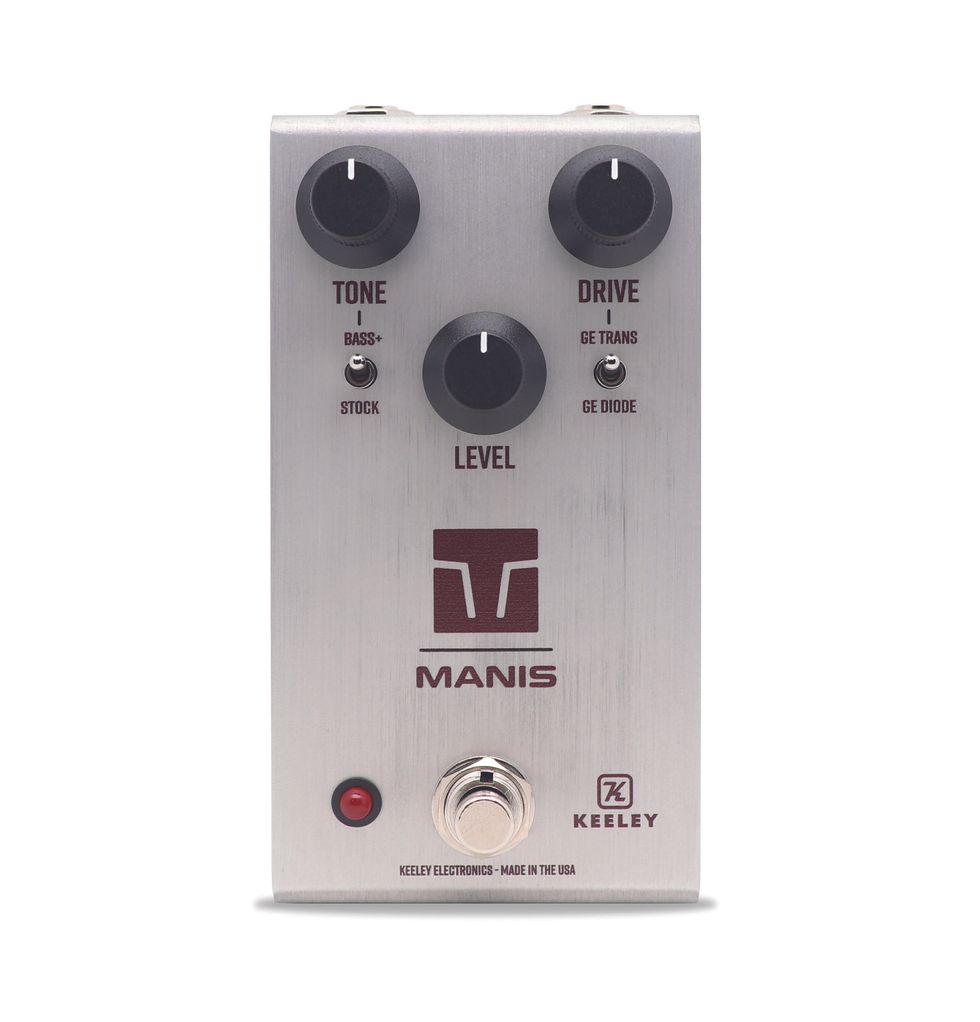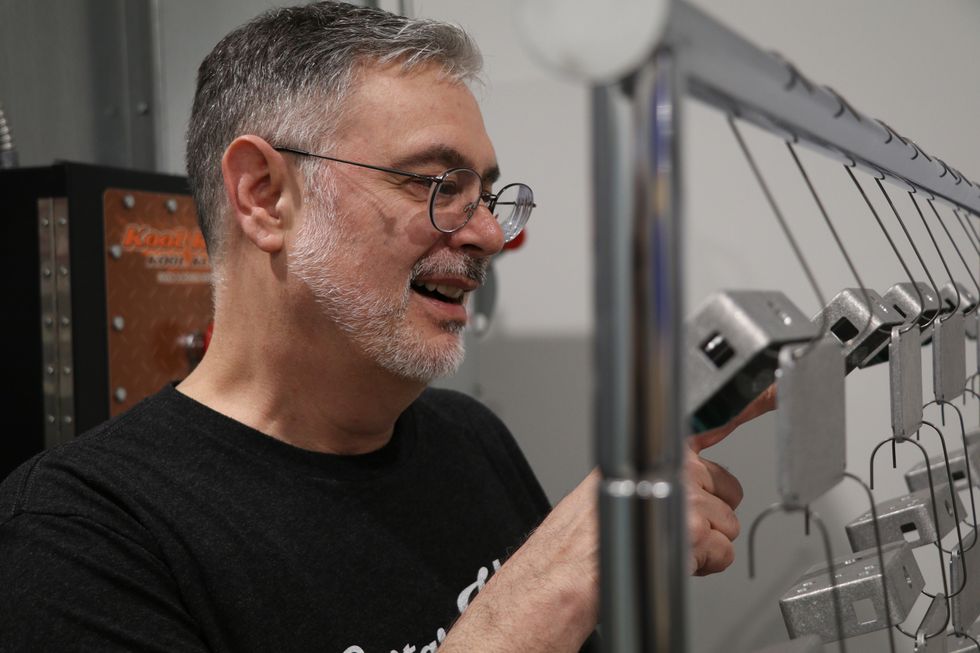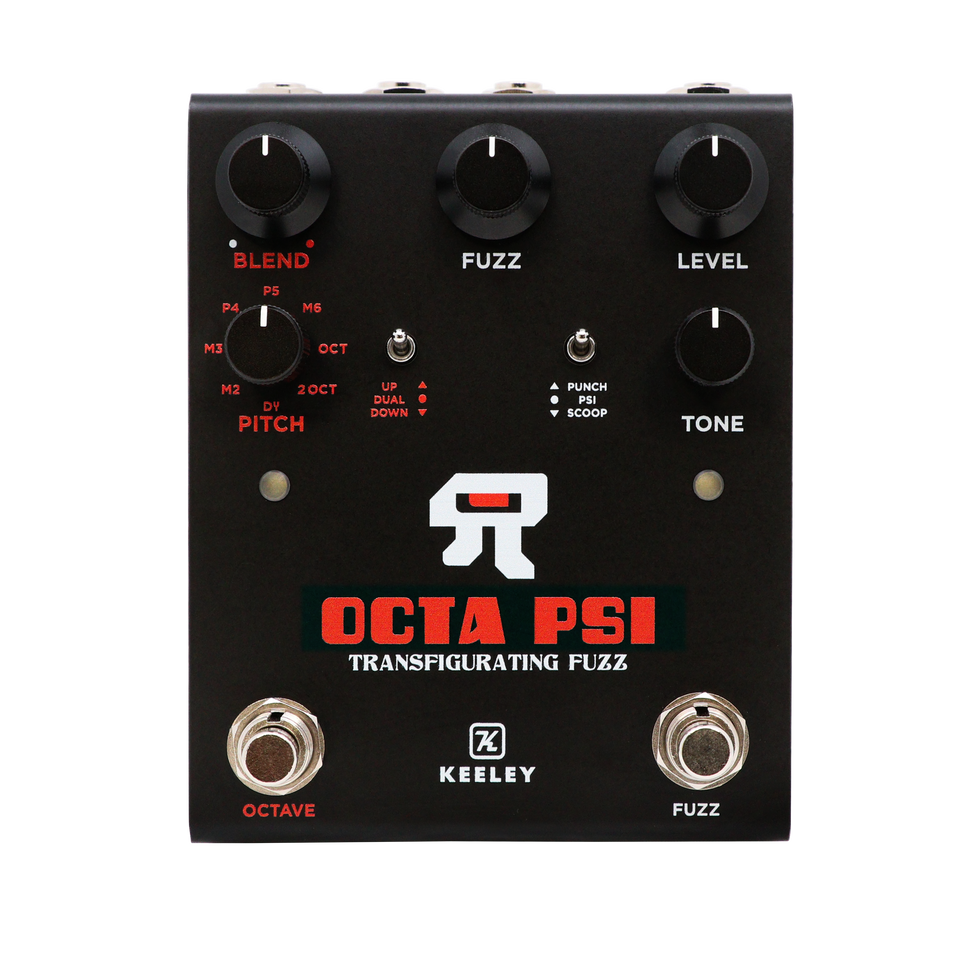If you’re into modding guitars, there has never been a better time in terms of options for hardware, electronic components, and, of course, pickups––especially for fans of Fender offsets, where one quick Google search calls up an embarrassment of riches.
Over the last 20 years, pickup winders have benefitted these oft-maligned musical marauders by bringing to market a near-endless array of tone-twisting options. But with so many to sift through, it can be a tall order to pick out the crème de la crème.
If you’re looking to change up the sound of your Jazzmaster, here’s a rundown of some of my favorites from having swapped out hundreds upon thousands of pickups over the years.
Setting a Baseline
It’s a fairly safe assumption that the majority of you reading this article might be starting with stock Fender pickups, whether your guitar is a Squier, MIM, MIJ/CIJ, or U.S. model. Even within that space, Fender hasn’t made it too easy to know what it is you actually have. The popular Squier J Mascis model, for instance, features P-90s stuffed under Jazzmaster covers; same goes for the Classic Player line.
What exactly is a “proper” Jazzmaster pickup, then? Succinctly, it’s a wide, flat coil wound hot around six alnico rod magnet poles. Fender’s popular Pure Vintage ’65s fit that bill, so let’s use them as our baseline here. They’re a fine representation of what a Jazzmaster sounds like, though I’d point out that they’re a bit thin and underpowered at 6.5k ohms, compared with actual vintage units which typically measure out in the mid 7s through the high 8s.
So, where do we go from here? Let’s start with “vintage” sounds, then work our way forward in time.
The black-bobbin pickups on early ’58–’62 models are generally louder and darker than the gray-bobbin ones found on ’64 and later guitars, with a few changes to wire type and magnet type in between that had a marked effect on the sound. For era-correct tones, I recommend the following, broken into two generalized groups:
’50s

Seymour Duncan Antiquity I Jazzmaster pickups, sans cover
Seymour Duncan’s Antiquity I ($238/set street) set is a great over-the-counter option for a fuller, more present pickup that will add some much-needed girth to your sound. They feature alnico 2 rod magnets and average DC resistance over 8k in both positions, and are wax-potted to reject feedback.
The Antiquity I bridge pickup shines with some sorely-needed low end, while the neck pickup stays warm and syrupy. These are great if you want to tackle jazz and rock tones with your offset.
“The black-bobbin pickups on early ’58–’62 models are generally louder and darker than the gray-bobbin ones found on ’64 and later guitars, with a few changes to wire type and magnet type in between that had a marked effect on the sound.”
In need of a more robust treatment? Curtis Novak’s Historic line seeks to faithfully replicate four different eras of Jazzmaster pickup construction, but Curtis’ finely tuned ear has allowed him to hone in on the specs and frequencies that really make a guitar sing.
Guitars lacking low-midrange thickness can be improved with Novak’s Historic ’58 ($145 street) set and ’58-FAT models ($170 street), the latter adding even more heft to the bridge position and making it ideal for distorted tones. Rich and decadent like lava cake, the Historic ’58 is among my most recommended sets.
’60s
Seymour Duncan’s Antiquity II ($238/set street) strikes out at that mid-1960s Jazzmaster sound: brighter, sweeter, clearer. Featuring A5 magnets with similar resistance readings to the AI set, the added treble zing makes these pickups great choices for twangy surf, country, and 2020s lightly driven indie tones.
Back to Curtis Novak, he once again rises to the challenge with his Historic 1960-1964 ($145 street) and 1965-1969 ($145 street) sets, both of which emphasize treble definition with relaxed midrange. Quintessentially ’60s, any of the above options will jangle to your heart’s content.
Time Travelling
Now, the fun of having such distinct eras of pickups to choose from is the ability to mix and match tones for your own needs. When I’m building sets for a specific guitar, I’ll grab an Antiquity I bridge and a II for the neck, or a Novak ’58-Fat and ’64 combo which lets me get the best of both eras: a darker, heartier bridge pickup with a brighter neck, with the added bonus of a thrillingly complex middle position.
The point is: don’t be afraid to experiment with different pickups in either position!
Modern
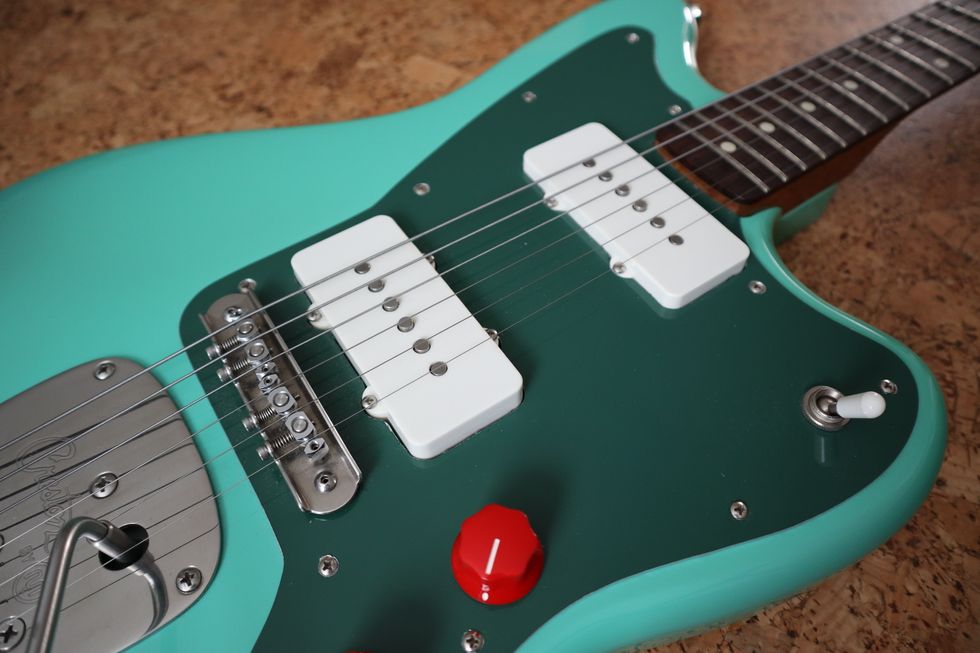
A beloved Creston JM with Lollar Jazzmaster pickups
For many years at this point, Jason Lollar made a singular Jazzmaster set that served as the benchmark of a good, strong-sounding pickup. Like everything that comes out of his shop, that set has a sort of hi-fi quality to it: lots of clarity, dynamic articulation, perfectly suited for blues, rock, or funk sounds.
That’s not to say Lollar’s Jazzmaster pickups hold no connection to their Fender forebears, but rather that the Lollar sound is so unique and refined that categorizing them as purely “vintage” feels unnecessarily limiting.
That set is still in production, recently renamed Lollar Original ’58 ($115 street) but retaining its design hallmarks, including radiused pole pieces for truly balanced string-to-string response and a mid-8k DC resistance range. It’s a classy affair that feels like dressing up your guitar in a tuxedo. The name’s Lollar. Jason Lollar.
“When I’m building sets for a specific guitar, I’ll grab an Antiquity I bridge and a II for the neck, or a Novak ’58-Fat and ’64 combo which lets me get the best of both eras: a darker, heartier bridge pickup with a brighter neck, with the added bonus of a thrillingly complex middle position.”
Along with that name change, Lollar has also introduced a companion set known as the Lollar ’63 ($115 street), based on the pickups found in repair tech Jeff Hoppe’s personal instrument. The ’63 incorporates a fuller-sounding neck pickup, flat A2 poles, and matched DC resistance readings between the pickups for a bright yet percussive voice.
Last but not least, there’s also the exclusive Lollar Black Bobbin set, a co-venture with the Chicago-based shop helmed by Shelby Pollard. With radiused A2 poles and lower output, this set mimics the sound of 60-year-old pickups for a darker tone than the Original ’58.
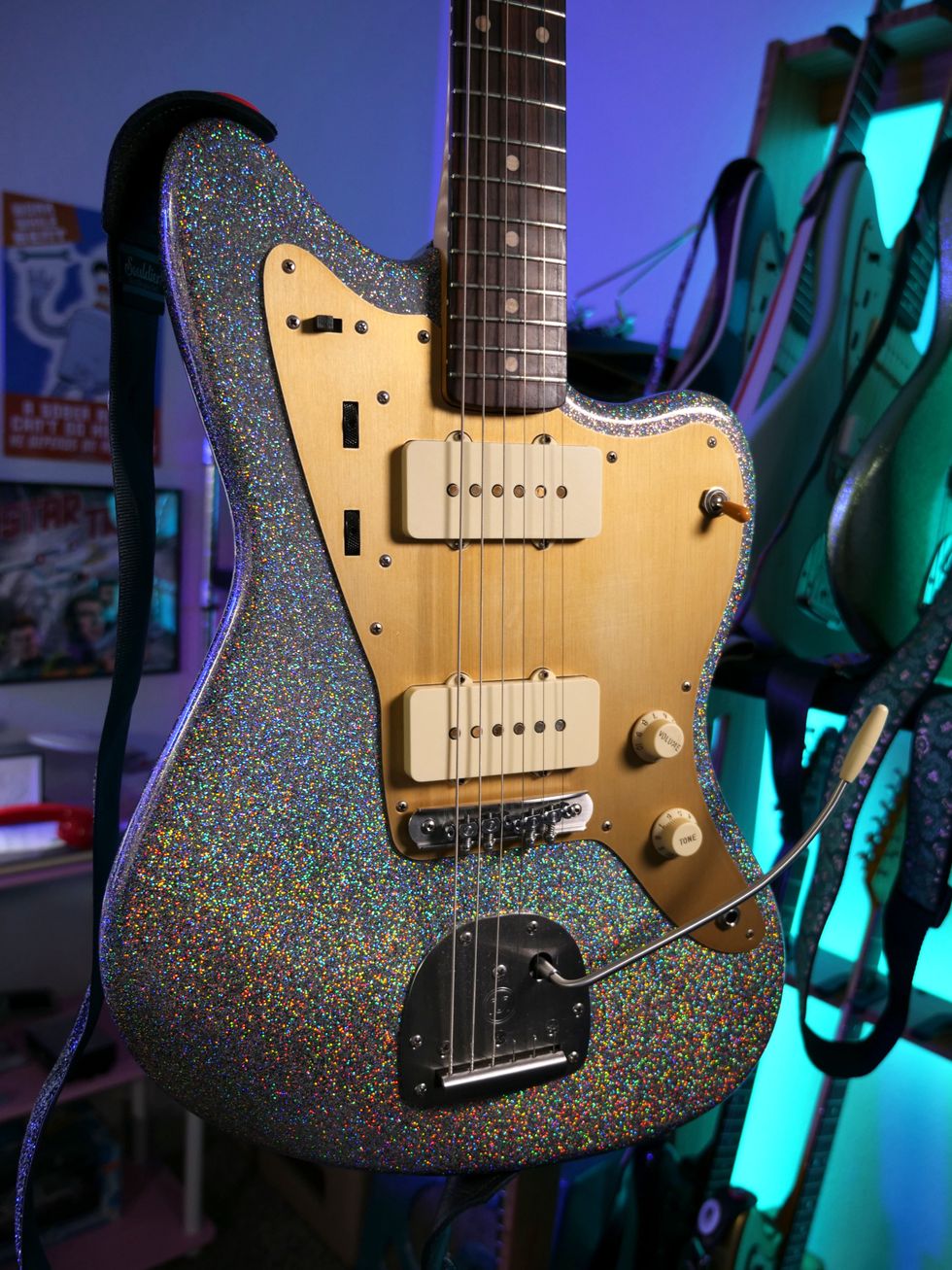
The author’s ’58-style holoflake JM loaded with a set of Sunday Handwound’s 5859s
I would be remiss if I also didn’t give a shoutout to Sunday Handwound and their incredible 5859 set ($145/set). The name might fool you into thinking this recommendation belongs in the ‘vintage’ category, but like the Lollars, this set takes its inspiration from the old and blends it with the new.
Inspired by a custom Stratocaster set wound for a customer, the 5859s retain the general Jazzmaster construction ethos with some careful re-voicing to make them bigger, bolder, and punchier than you’re likely to hear from stock pickups. Better yet, the bridge is overwound for a meaner personality, making it ideal for heavier single-coil tones.
I have the 5859s in my gold-guard holoflake Jazzmaster, and let me tell you, they are formidable. Loud and low-noise, superb for stage use. Paired with a Muff-style fuzz and some delay, I feel like I’m David Gilmour.
P-90
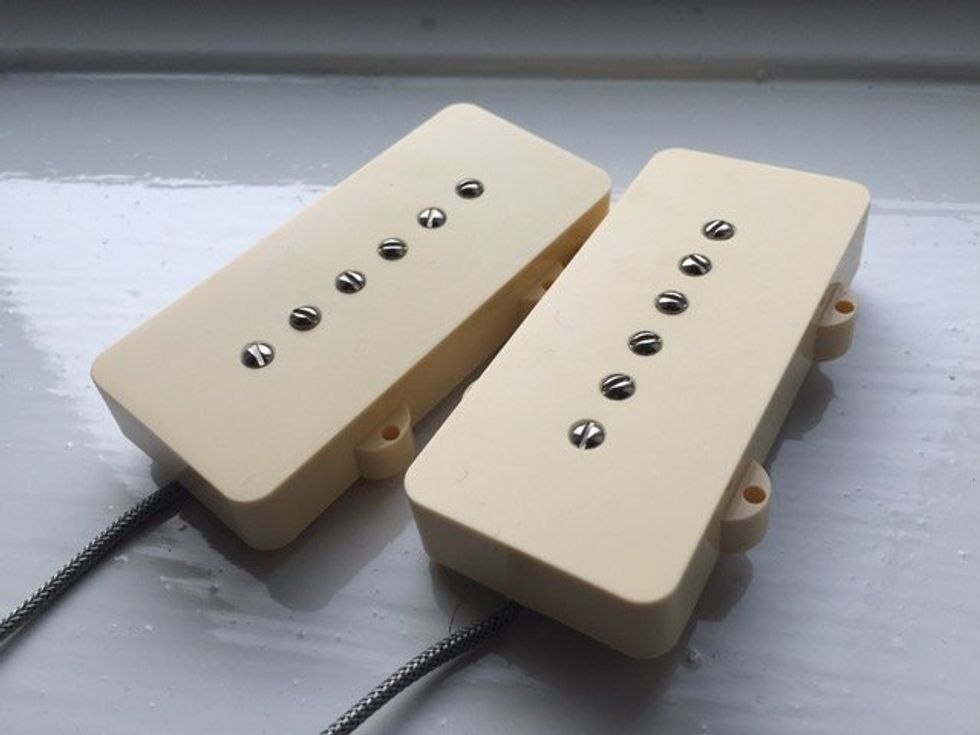
P-90 Jazzmaster pickups by The Creamery
For those about to rock, we politely suggest starting here.
If your tastes skew into the Gibson realm, you’ll be happy to learn that most of your favorite winders probably already make the perfect pickup for you in the form of a P-90 in a Jazzmaster-shaped bobbin.
To name a few, Creamery’s P90 Jazzmaster ($115 street), Fralin’s Steel-Pole ($115 street), Lollar’s P-90 for Jazzmaster ($145 street), Novak’s JM-90 ($140 street), and Porter’s J90 ($130 street) will fit the bill here. They all marry true P-90 bar magnet construction with a relatively Jazzmaster-like coil shape, so you get the more aggressive midrange bark of a P-90, but with some snap on top for good measure.
When using a P-90 in a Jazzmaster, do take your potentiometers into consideration. Each of these options sound great with the brightness of the stock 1M pots but can be declawed by stepping down to 500k as you’d find on a proper P-90-equipped Gibson. Again, don’t be afraid to experiment!
Humbucker

Lambertone’s Crema set
Throwing humbuckers in a Jazzmaster turns it into a Jazzblaster, something I back fully. I adore my single-coils, but there’s something undeniably fun about slapping some double-coils in your trusty offset guitar.
Companies like Lambertone make this easy with the ability to grab their PAF-inspired Crema ($345/set street) model under a Jazzmaster cover, and the same goes for the Curtis Novak JM-PAF ($175 street). The McNelly Jazzmaster HB ($155 street) does a similar thing but allows you to select any of their traditional humbuckers for a drop-in fit.
Wide Range
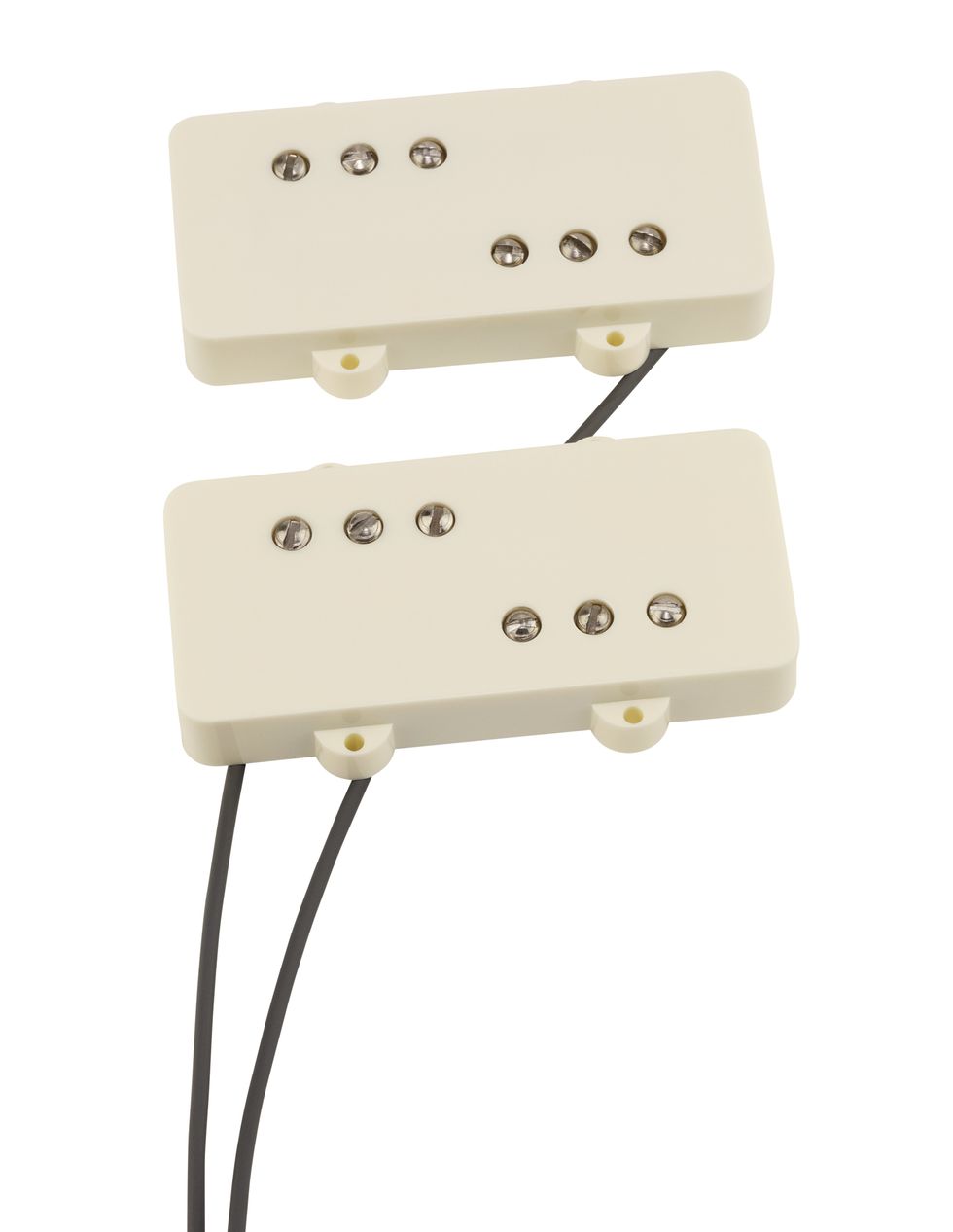
Fender’s Cunife Wide Range Humbucker set for Jazzmasters
Although first introduced on Telecasters in 1971, and later appearing as standard on Fender’s semi-hollow Starcaster, there is perhaps no other humbucker model that feels like a perfect match for Jazzmasters than Fender’s Wide Range pickup. Paradoxically single-coil-like in response, these massive humbuckers deliver big output, complex low end, and attenuated yet crisp highs.
Accounting for this, Curtis Novak, Creamery, and Porter have for years offered drop-in wide range pickups with appropriate plastic covers, and Lollar joined in a few years back with their Regal for Jazzmaster ($225 street) set. Each of these winders have a different take on the wide range, but they all sound excellent. Seriously, there’s not a bad sound in the bunch.
“There is perhaps no other humbucker model that feels like a perfect match for Jazzmasters than Fender’s Wide Range pickup.”
Just this year, Fender released their own drop-in Cunife (Copper, Nickel, Iron) Wide Range pickups ($399/set street), the company’s first proper wide ranges since the ’70s. With the correct magnet type in play, this is a return to form for the wide range with a vintage-correct sound.
Better yet, each of the makers listed in this section offer the original massive, chrome-covered versions of these pickups, so there’s nothing stopping you from dropping them in your guitar—at least, nothing aside from some routing.
Noiseless
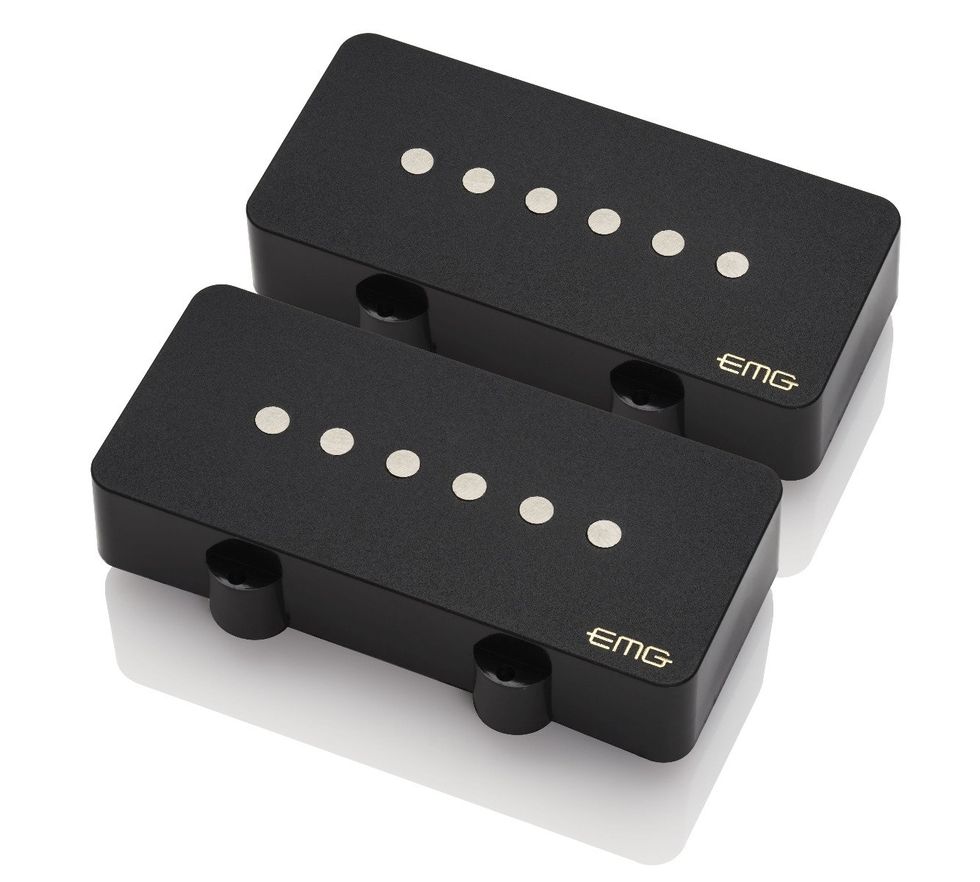
EMG’s JMaster set in black
Since we’re in the hum-canceling wheelhouse, let’s talk about noise. For some, it’s an unavoidable nuisance and a trade-off for having a preference for the sound and response of true single-coils. For others (myself included), it’s far from the top of the list of guitar-related annoyances. In all honesty, it doesn’t bother me at all, but I’ll admit that I have my signal chain wired up for the lowest possible noise, my guitars are well-shielded, and I roll off my volume when not playing.
For the former group, there is hope! Kinman should be an already familiar name in the noiseless pickup landscape, and we’re all lucky that the company offers a whole host of Jazzmaster options that includes three types of pole-piece spacing, and four different models to meet the needs of individual players: the FatMaster ($189 street), SurfMaster ($189 street), the double-voiced SurfMaster DV ($295 street), and the ThickMaster ($189 street).
It’s not so difficult to intuit the sound profiles from the names of these pickups, so I’ll refrain from describing them here. What I can say is that every experience I’ve had with these pickups has been stellar, so if you’re sensitive to hum but also what’s lost with most hum-canceling options, Kinman may be the ideal solution for you.
Other excellent noise-free pickups come from Brandonwound with their Noiseless Jazzmaster ($125 street), Novak’s JM-Stealth HC ($170 street), Fralin’s Hum-Canceling Jazzmaster ($159 street), and EMG’s JMaster ($229/set street) sold as a pickguard assembly or in pickup sets.
I could write a standalone piece about the EMGs, but to sum up: I find them genuinely impressive in their versatility and utility, and the JMasters somehow stay true to the Jazzmaster flavor. If you’re already an EMG fan, the JMaster is totally worth your time.
Off the Beaten Path
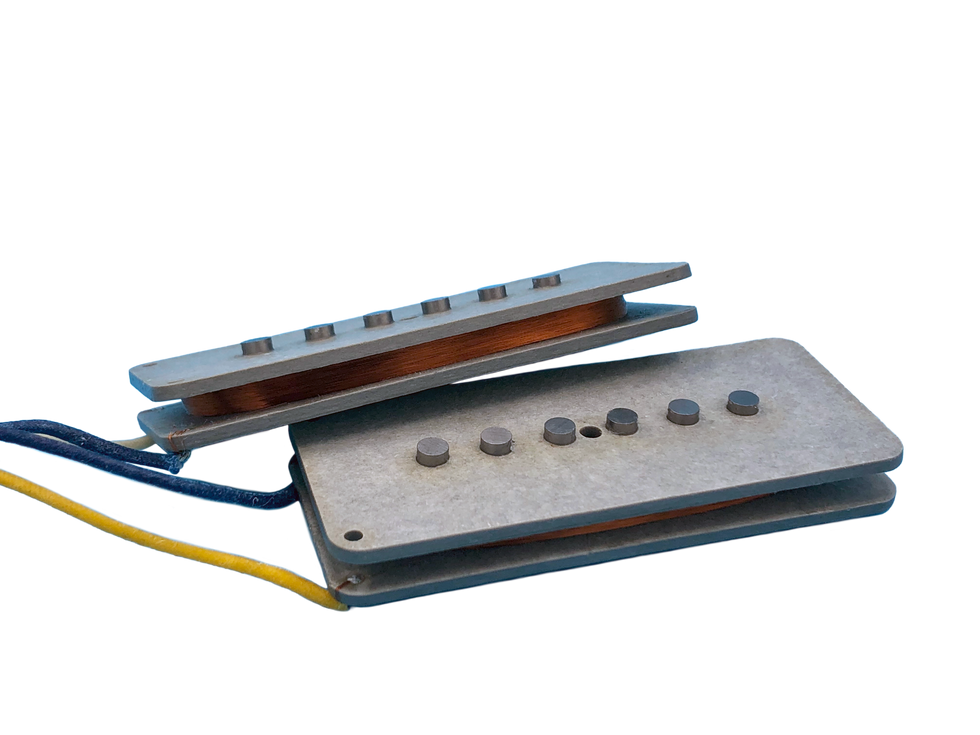
EP Custom Pickups Vintage Correct Jazzmaster Pickups
Before we close out, let’s take a detour on roads less traveled. Most of the makers I’ve already mentioned have quirkier, less ‘standard’ pickups in their catalog. I’m thinking Novak’s Gold Foils for Jazzmaster ($155 street), Gemini’s SuproCaster ($85 street), Lollar’s Blademaster ($155 street), and Fender’s Cunife/Cobalt Chrome Jazzmaster pickups ($299/set street), but there are some smaller brands that I think deserve some attention.
EP Custom is a small operation based out of Santa Cruz, California, that specializes in Fender-style pickups with sounds that far exceed their modest price tag. Ever since installing their ’62 Jaguar set in my Coke Bottle Sparkle Jaguar––a tribute to Dave Wronski of Slacktone––I can hardly think of a more perfect-sounding Jaguar for myself.
EP’s Jazzmaster pickups are equally exceptional and come in two flavors: Vintage Correct ($170/set street) and Fat ($180/set street). The former features Formvar wire and has comparable output and tone to a proper 1958 set, woody and full-sounding with a nice amount of zing. The Fat is overwound for a proper ‘hot’ pickup, with a growl perfectly suited for overdrive.
The Creamery: The majority of winders named in this article are based in the United States. With acknowledgement to the connected world we all live in, I wanted to give a proper shout to The Creamery (see the “wide range” heading above) based out of Manchester, U.K.
For as long as I’ve been in the offset-guitar space, The Creamery has been one of my most consistent recommendations for folks outside the U.S. who are looking for something different, something unique, something that feels specially made for them. Creamery offers everything from classic Jazzmaster pickups, wide range, and PAF-style pickups, but also an extensive list of custom options. Pole spacing, magnet type, wire––you name it.
Whether you’re within or without the U.K., keep The Creamery in mind if your tastes take you off the beaten path.
Black Mass: You may already be familiar with Black Mass Electronics thanks to the game-changing 1312 Distortion, a RAT-style pedal that boasts a huge range of sounds thanks to its 8-way clipping diode selection dial. What you may not be aware of is that Black Mass has entered the pickup winding world with the JMXL ($190/set street).
While it appears to be a traditional Jazzmaster pickup on the outside, it boasts 1/4" alnico 5 rod magnets and a double-tall coil with the bridge wound to around 11k. This is a heavy, punishing set that’ll put you in the mood for doom.Winding Up
With an article like this, it’s impossible to feature every winder out there, each of them putting their own spin on dozens of classic designs. I’ve attempted to narrow down the list by sticking to pickups I have real-world experience with, so if something you love isn’t on this list, that doesn’t mean it’s not great. Drop a line to call out your favorites so that we can all benefit from your experience, too!






